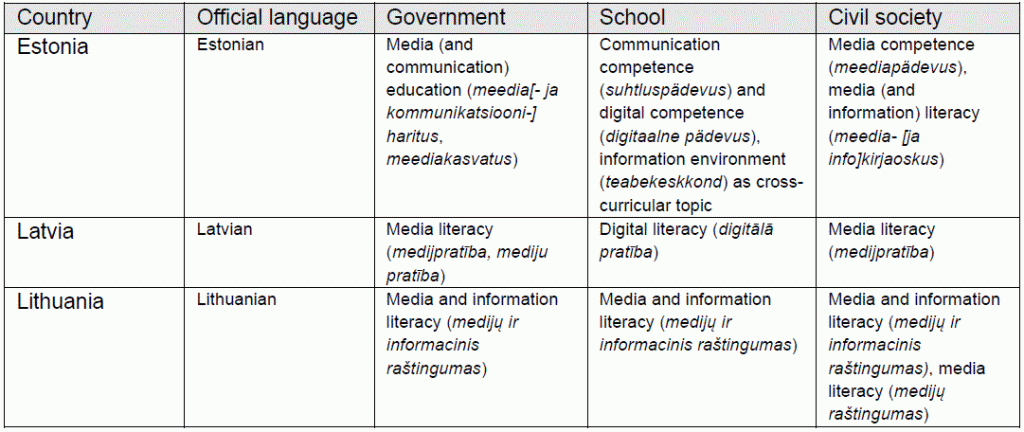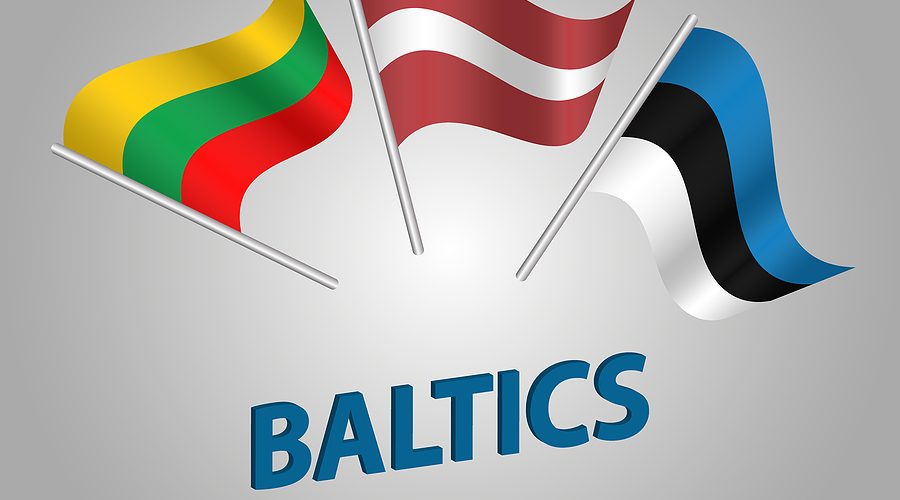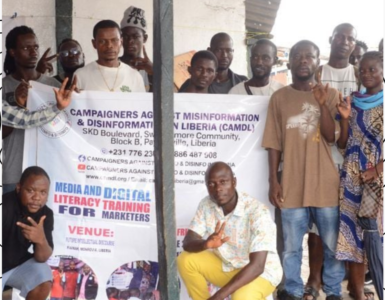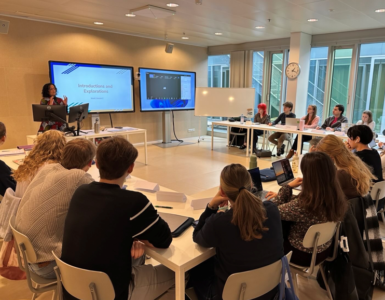Join us on Wednesday 9 December at 15:00 CET for our monthly Wednesday Webinar series on media literacy when the spotlight will be on the Baltic countries. This series is run by the Media & Learning Association and Nordicom and each month we focus on different countries, places are still available, register here.
Estonia, Latvia and Lithuania are small countries with limited media markets, with three different national languages and a common history. In total, just over 6 million inhabitants live there, making them together a little larger than the neighbouring countries of Denmark (5.8 million) and Finland (5.5 million).
What the Baltic states have in common – and what also makes them interesting – is, above all, their Post-Soviet past, and the continued geo-cultural proximity of neighbouring Russia, implying the existence of Russian-speaking minorities in these counties. While the Post-Soviet or countries-in-transition framework has become a common nominator to talk about these countries, the countries themselves are not always eager to stress their common past. Instead, they want to look forward, and since their independence there has been a powerful identification with the West, which goes hand in hand with a strong affinity with the Nordic countries and alignment with European policy guidelines.
What is also noteworthy, is that Baltic nationhood – connected to the idea of citizenship, which plays a central role in media literacy – is relatively young. In the Middle Ages, Lithuania was part of the Polish-Lithuanian Commonwealth and developed close ties with the Catholic tradition, the nation states Latvia and Estonia came into being in 1918. During the Soviet time, the notions of Estonian, Latvian or Lithuanian citizenship were largely suppressed by the regime. Having gained independence in 1991, Estonia and Lithuania became members of the Council of Europe in 1993 and Latvia in 1995, becoming part of the European Union in 2004.
Core concepts of media literacy
Despite similarities, there are also striking differences between the Baltic countries. When it comes to conditions of promoting media literacy, the neighbours show notable differences. In the Media Literacy Index by the Open Society Institute in Sofia, ranking 35 European countries, Estonia belonged to the cluster 1, together with other Nordic countries and Germany, which are assessed as being the best equipped for media literacy-related challenges. In this index, Estonia was ranked in 5th position, after Finland, Denmark, the Netherlands and Sweden. Latvia and Lithuania, on the other hand, were categorized as belonging to cluster 2, being 17th and 19th on the list.
In each country, there are one or two core concepts that to a significant extent define the understanding of media literacy, and significantly inform practice and development. The table below pinpoints the core concepts employed in the sectors: at the governmental level, where media literacy is typically governed as a cross-sectoral issue, school, and in civil society, where the role of non-governmental organisations and media literacy projects are the key.

Source: Jaakkola, Maarit (2020). Editor’s introduction: Media and information literacy research in countries around the Baltic Sea Central European Journal of Communication 13 (2/26), p. 151.
Estonia is internationally well-known for its promotion of e-governance. In the current Estonian school curriculum updated in 2014, ”communication competence” and ”digital competence” are mentioned as general competences to be developed among pupils. The curriculum also identifies eight cross-curricular topics, among which information environment is the most relevant to media literacy. The Estonian word pädevus for ”competence” has a positive tone associated with qualification, and the word haritus (as in meediaharitus for ”media education”) refers to practice.
The report entitled A study on the state and trends of media policy from last year, written by academics from the Universities of Tartu and Tallinn, suggested that the improvement of media and language education should be a better-prioritized aspect in media policy. According to the report, strategy documents should pay much more attention to the media and communication education. The report points out that media education in Estonia has primarily been associated at the policy level to the fields of strategic communication, marketing communication, and general information literacy. New plans related to media literacy issues may therefore be expected in the near future.
Instead, the mass media policy guidelines in Latvia, set up for 2016–2020, explicitly address the ”media literacy of the audience”. The skills of critical analysis of media content and creative skills to produce messages are expected to ”reduce one-direction influence of mass media communication, allowing to identify and prevent the distribution of biased information”. The Latvian term for media literacy, medijpratība, means ”media practice”. School curricula, updated 2018, employ the overall term digitālā pratība, digital practice, or competence, to which the critical analysis of media content is subordinated.
In Lithuania, there are strategic guidelines for media policy covering the years 2019–2022, issued by the Ministry of Culture. Media and information literacy, in Lithuanian medijų ir informacinis raštingumas, is regarded as a central way of strengthening the resilience towards the dissemination of disinformation and propaganda. The increase of the level of media literacy competence in the population, which was for the first time measured in 2017 and set to 37.8 per cent and expected to increase to 41.3 per cent by 2023, is set as an objective. Even the general school curricula in Lithuania, from 2017, explicitly mention the term media and information literacy, yet as activities that shall be organised according to the possibilities at school.
Educating media literacy
Cooperation and the exchange of ideas are not always easy even if crossing geographical boundaries would be easy in countries that are geographically close to one another. Media literacy is strongly connected to language, as communication in mass media is published in national languages. As there are three Baltic national languages – however, strictly speaking, only Latvian and Lithuanian are the Baltic languages, while Estonian belongs to the Fenno-Ugric family of languages – the neighbours do not necessarily have direct access to each others’ media content.
In higher education, media literacy is increasingly seen as an important area for collaboration. Next year, a Baltic joint Master’s programme in media literacy will be launched by three Baltic universities and one Polish university, coordinated in Riga. Previously, media education has been taught at the University of Tartu in Estonia, and in Latvia there is a Master’s study programme in media and information literacy at the Vidzeme University in Valmiera.
Editor’s note; You can read more in A Special Issue on media literacy in the Baltic countries in Central European Journal of Communication, edited by Maarit Jaakkola and Agnieszka Stepinska (Vol. 13 No. 2/26)

Author
Maarit Jaakkola, PhD, Associate Professor, is working as the co-director at Nordicom, a centre for Nordic media research at the University of Gothenburg, Sweden.














